Scaleless Head Pied Ball Python For Sale
$899.99
WE HAVE ASCALELESS HEAD PIED BALL PYTHON FOR SALE. HERE ARE SOME HIGHLIGHTS:
- Python regius
- Snake was produced from Scaleless Head Pied X Enchi Pied
- Captive Bred 2021
- Approximately 14 – 16 Inches In Length
- Roughly 38 Grams And Growing
- When Hatching Out Of The Egg They Can Be As Small As 10 Inches And Grow To Be 5 Feet
- Feeding On Live Hopper Mice Weekly
FUN FACTS!
- Ball Pythons Are Native To Central And Western Africa And Thrive In These Warm, Tropical Areas
- Great For A First Time Keeper As Well As An Experienced Breeder
- With Proper Care And Setup These Snakes Can Live 20 – 25 Years In Captivity
Scaleless Head Pied Ball Pythons
The scaleless head pied ball python is a captivating morph that has captured the attention of reptile enthusiasts around the world. This unique variant of ball python, known for its distinctive physical characteristics, stands out in the diverse spectrum of ball python morphs. Ball pythons, in general, are admired for their manageable size, docile nature, and the vast array of color and pattern morphs that breeders have developed over the years. However, the scaleless head pied ball python takes this fascination to another level.
What truly sets the scaleless head pied ball python apart is its combination of two remarkable traits: the scaleless head and the pied (piebald) pattern. The scaleless head is a partial expression of the scaleless gene, resulting in a smooth, scale-free head while the rest of the body retains its typical scales. This feature not only adds a unique visual element but also sparks curiosity about the genetics behind it. The pied pattern, on the other hand, is characterized by large, irregular patches of white interspersed with areas of normal pigmentation, creating a striking and visually appealing contrast.
These physical attributes make the scaleless head pied ball python a subject of significant interest among breeders and collectors. The allure lies not only in its aesthetic appeal but also in the genetic intricacies involved in producing such morphs. The combination of scaleless and pied traits requires careful breeding strategies, making each successful hatchling a testament to the breeder’s expertise and patience. This morph’s popularity continues to grow as more reptile enthusiasts seek out these extraordinary specimens to add to their collections.
In essence, the scaleless head pied ball python exemplifies the innovative and ever-evolving nature of reptile breeding. Its unique appearance and the challenge of breeding it successfully make it a prized addition to any collection, reflecting the ongoing fascination with these remarkable creatures.
Origin and Genetics
The scaleless head pied ball python is a captivating morph that has garnered significant interest among herpetology enthusiasts and breeders alike. This unique morph is a result of intricate genetic engineering, combining specific traits through selective breeding. Understanding its genetic background requires a grasp of how dominant, co-dominant, and recessive genes function in ball pythons.
The scaleless head trait itself is a co-dominant gene. This means that when a ball python carries one copy of the scaleless gene, it exhibits a noticeable reduction in the number of scales on its head, hence the name “scaleless head.” When two copies of the gene are present, the result is a fully scaleless ball python. The pied trait, on the other hand, is a recessive gene that causes large patches of the snake’s skin to lack pigmentation, resulting in a striking pattern of white and colored patches.
Breeders have meticulously combined these traits to produce the scaleless head pied ball python. The breeding process involves pairing ball pythons that carry the scaleless head gene with those that carry the pied gene. Through selective breeding and understanding of Mendelian genetics, breeders can predict and produce offspring that exhibit the desired combination of traits. The offspring’s appearance depends on the specific combination of inherited genes, with some displaying the scaleless head trait along with the pied pattern, while others may carry only one of the traits or neither.
The genetic relationship of the scaleless head pied ball python to other morphs is equally intriguing. For instance, combining the scaleless head gene with other color and pattern morphs can result in a myriad of visually stunning variations. This genetic interplay highlights the versatility and potential within ball python breeding, as breeders continue to explore new combinations and refine existing ones. As the understanding of ball python genetics deepens, the development of new and unique morphs like the scaleless head pied is likely to continue, contributing to the ever-expanding diversity within the species.
Physical Characteristics
The scaleless head pied ball python stands out prominently due to its distinctive physical traits. One of the most striking features is the absence of scales on its head. This scaleless region creates a smooth, almost glossy appearance that contrasts sharply with the rest of its scaled body. The scaleless head is not only a unique aesthetic attribute but also a tactile difference, offering a softer texture compared to the scalier parts of the snake.
In addition to the scaleless head, the coloration of this morph is particularly eye-catching. The pied pattern, characterized by irregular patches of white interspersed with darker, typically brown or black, pigments, adds to the visual appeal. These patches can vary significantly in size and distribution, making each individual snake truly unique. The contrast between the white pied sections and the darker colors provides a striking visual display that distinguishes it from other ball python morphs.
Furthermore, the scaleless head pied ball python exhibits the common features of ball pythons, such as a muscular, robust body and a relatively short, thick tail. However, the pied pattern and the scaleless head set it apart from the standard ball pythons, which usually have a more uniform coloration and fully scaled heads. This morph also tends to have a slightly more varied and vibrant color palette compared to other morphs, enhancing its unique appearance.
These physical characteristics not only make the scaleless head pied ball python a fascinating subject for reptile enthusiasts but also contribute to its popularity in the pet trade. Its rare combination of scaleless head, pied pattern, and distinctive coloration makes it a highly sought-after morph among collectors and breeders alike. The visual and tactile uniqueness of this python underscores the incredible diversity found within the species and highlights the remarkable possibilities of selective breeding in reptiles.
Behavior and Temperament
The scaleless head pied ball python exhibits a fascinating array of behaviors and temperament traits that make it a unique and intriguing pet. Known for their generally docile nature, these pythons tend to be calm and manageable, making them suitable for both novice and experienced reptile enthusiasts. Like other ball python morphs, scaleless head pieds are known for their relatively sedentary lifestyle. They spend a considerable amount of time coiled up in hiding spots, emerging primarily during the evening and night hours, which aligns with their natural nocturnal instincts.
In terms of activity levels, scaleless head pied ball pythons are not overly active, but they do exhibit bursts of curiosity, especially during feeding times or when exploring new environments. Their feeding habits are quite similar to those of other ball pythons. They typically prefer smaller prey items such as mice or young rats, and feeding sessions are usually once every week or two, depending on the snake’s age and size. It’s essential to maintain a consistent feeding schedule to ensure their health and well-being.
When interacting with humans, scaleless head pied ball pythons generally display a placid demeanor. They are rarely aggressive and, when handled gently and regularly, they can become quite accustomed to human interaction. This morph’s temperament is often compared favorably to other ball python morphs, as they tend to be less defensive and more tolerant of handling. However, as with any reptile, individual temperaments can vary, and it’s crucial to observe and respond to each snake’s unique behavioral cues.
Overall, the behavior and temperament of scaleless head pied ball pythons make them a captivating addition to any reptile collection. Their calm nature, combined with their striking appearance, offers a rewarding experience for owners who are willing to invest the time to understand and care for these remarkable creatures.
Housing and Care Requirements
Proper housing and care are paramount for ensuring the health and well-being of a scaleless head pied ball python. When setting up an enclosure, it is essential to provide an environment that closely mimics their natural habitat. A 20-gallon tank is typically suitable for a young python, but as they grow, adults will require a larger enclosure, ideally around 40 gallons. A secure, well-ventilated enclosure with a tight-fitting lid is crucial to prevent escapes.
Temperature regulation is a critical aspect of caring for scaleless head pied ball pythons. These reptiles thrive in a temperature gradient, with a warm side of the enclosure maintained at 88-92°F and a cooler side at 78-80°F. This gradient allows them to thermoregulate by moving between warmer and cooler areas. Using a reliable thermostat to control under-tank heating pads or ceramic heat emitters can help maintain consistent temperatures. Additionally, nighttime temperatures can safely drop to the mid-70s°F, reflecting the natural cooling they would experience in the wild.
Humidity is another vital factor to consider. Scaleless head pied ball pythons require a humidity level of 50-60% to support healthy skin and proper shedding. Using a hygrometer to monitor humidity levels and misting the enclosure as needed can help maintain appropriate moisture levels. Including a water dish large enough for the python to soak in can also aid in maintaining humidity and provide hydration.
Substrate selection is equally important. Options such as aspen bedding, cypress mulch, or reptile carpet can be used to line the enclosure. These substrates are not only comfortable but also assist in maintaining humidity. Avoid using cedar or pine shavings, as they contain oils that can be harmful to reptiles.
Providing hiding spots is essential for the python’s sense of security. Incorporate multiple hides on both the warm and cool sides of the enclosure. These hides can be commercially available reptile hides or simple items like inverted flower pots with entry holes. Regular maintenance of the enclosure includes spot-cleaning waste daily and conducting a thorough cleaning monthly by replacing the substrate and disinfecting the enclosure.
By adhering to these housing and care requirements, you can create an ideal environment that promotes the health and longevity of your scaleless head pied ball python. Proper setup and regular maintenance are key to ensuring a thriving and content pet.
Diet and Feeding
The dietary needs of scaleless head pied ball pythons are quite specific and crucial for their overall health and well-being. In captivity, these pythons primarily consume a diet of rodents, such as mice and rats. It is important to tailor the size of the prey to the size of the python, ensuring the prey is not too large to avoid potential health issues, such as regurgitation or digestive blockages.
Feeding frequency for scaleless head pied ball pythons generally varies based on their age and size. Juveniles typically require more frequent feedings, approximately once every five to seven days, to support their rapid growth. As they mature, the feeding intervals can be extended to every seven to ten days. Adult pythons may only need to be fed once every two weeks, depending on their individual needs and metabolism.
Portion sizes should be appropriate to the size of the python, with the rule of thumb being that the prey item should be roughly the same width as the widest part of the snake’s body. This ensures that the meal is manageable and provides adequate nutrition without overfeeding or underfeeding. It is essential to monitor the python’s body condition and adjust feeding practices accordingly.
Ensuring proper nutrition for scaleless head pied ball pythons involves more than just providing prey. It is also important to offer a variety of prey types, such as alternating between mice and rats, to prevent nutritional deficiencies. Additionally, prey items should be sourced from reputable suppliers to avoid the risk of introducing parasites or diseases.
Feeding challenges may arise, such as a python refusing to eat. This can be due to stress, illness, or environmental factors. To address this, ensure that the enclosure is properly set up with the right temperature and humidity levels, minimize handling during feeding times, and provide a quiet and secure environment. If feeding issues persist, consulting with a reptile veterinarian is advisable.
Health Concerns and Common Issues
Scaleless head pied ball pythons, like all reptiles, can be susceptible to a variety of health concerns. Understanding these potential issues is paramount to ensuring the well-being of your pet. One of the primary concerns for scaleless head pied ball pythons is skin-related problems. Due to their lack of scales, they are more prone to abrasions and injuries, which can lead to infections if not properly managed. Regular inspections for cuts, sores, or any unusual marks are essential to prevent potential complications.
Respiratory infections are another common ailment that can affect these pythons. Symptoms to watch for include wheezing, nasal discharge, and lethargy. Maintaining proper humidity and temperature within their habitat is crucial to prevent such infections. Additionally, scaleless head pied ball pythons can suffer from parasitic infestations, both internal and external. Regular fecal examinations and skin checks can help detect and treat parasites early.
Nutritional issues may also arise if the snake’s diet is not appropriately balanced. Poor nutrition can lead to metabolic bone disease, characterized by weakened bones and deformities. Ensuring a diet rich in calcium and other essential nutrients is vital for their health. Moreover, these pythons can experience stress due to inadequate environmental conditions or handling, leading to a weakened immune system and increased susceptibility to illnesses.
To mitigate these risks, it is advisable to establish a relationship with a qualified reptile veterinarian. Routine health check-ups can help detect and address potential issues before they become serious. It is crucial to seek professional help if you notice any signs of illness, such as drastic changes in behavior, appetite, or physical appearance. A knowledgeable veterinarian can provide guidance on preventive measures and treatment options, ensuring the longevity and health of your scaleless head pied ball python.
Breeding Scaleless Head Pied Ball Pythons
Breeding scaleless head pied ball pythons requires meticulous preparation and a deep understanding of their unique needs. The journey begins with selecting healthy and genetically diverse breeding pairs. It’s essential to ensure that both the male and female are mature, typically between two to three years old, and in optimal health. Proper nutrition and a stable environment are critical components in preparing the pythons for the breeding season, which usually commences in the cooler months.
Pairing involves introducing the male to the female’s enclosure. Observing their interactions is crucial, as compatibility can significantly impact the success of breeding. Once copulation occurs, which may need to be repeated several times to ensure fertilization, the female will undergo a gravid period lasting approximately 45 to 55 days. During this time, providing a stress-free environment with optimal temperature and humidity levels is vital to support the developing eggs.
Incubation is the next critical phase. After the female lays her clutch, typically comprising four to six eggs, the eggs should be carefully transferred to an incubator set to a consistent temperature of about 88-90°F and humidity levels around 90-100%. The incubation period lasts about 55 to 60 days, during which regular monitoring is essential to ensure the eggs remain healthy and viable.
The hatching process is both thrilling and delicate. Once the hatchlings emerge, they must be placed in individual enclosures with appropriate heating, humidity, and hiding spots to mimic their natural habitat. Early care includes ensuring the hatchlings shed their skin properly and begin feeding. Offering small, appropriately sized prey items and maintaining clean enclosures are crucial for their growth and health.
Breeding scaleless head pied ball pythons comes with its set of challenges, including potential genetic complications and the need for precise environmental control. However, the rewards of successfully breeding and raising these unique morphs are immense. By adhering to best practices and remaining vigilant throughout the breeding process, enthusiasts can contribute to the thriving community of ball python morph breeders.
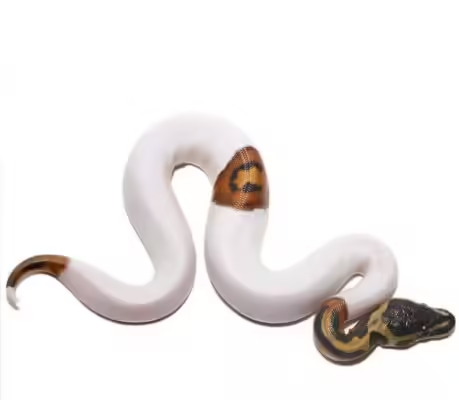





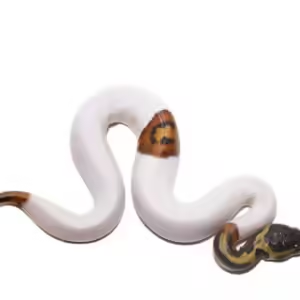
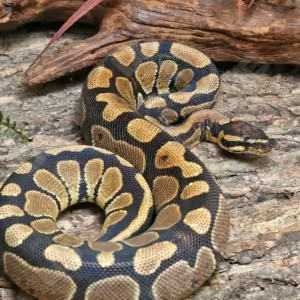



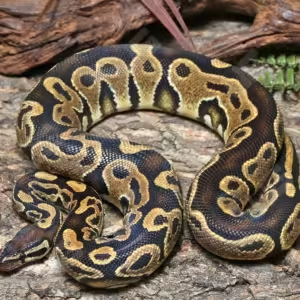


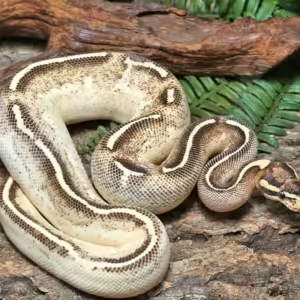





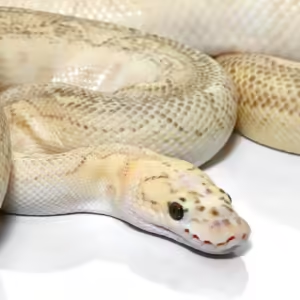
Reviews
There are no reviews yet.